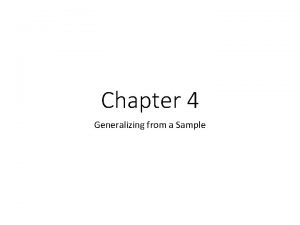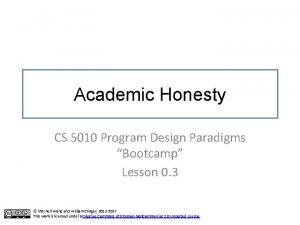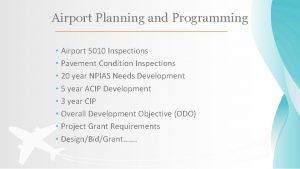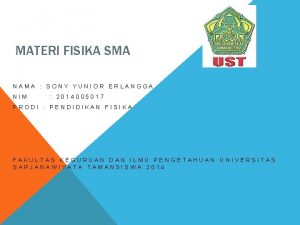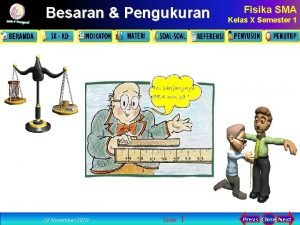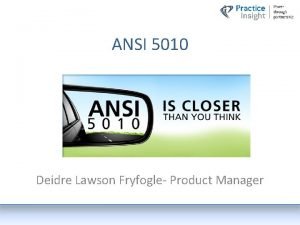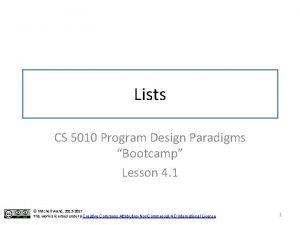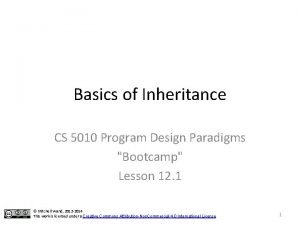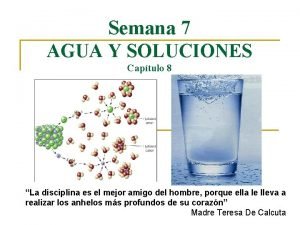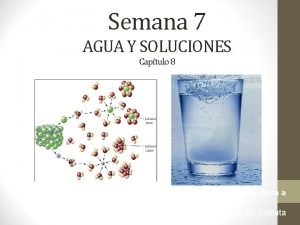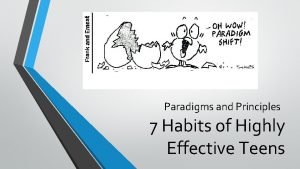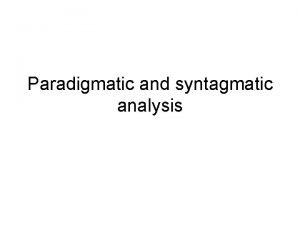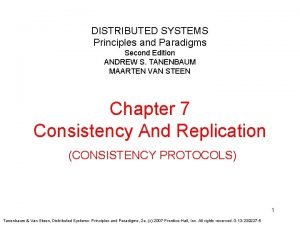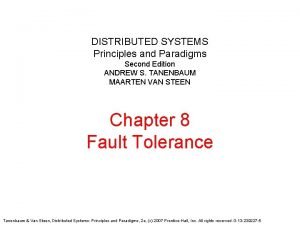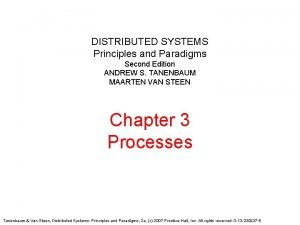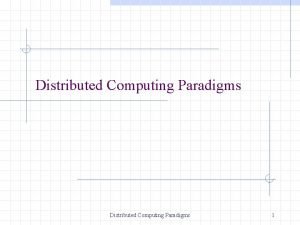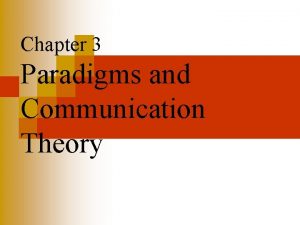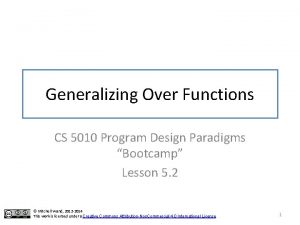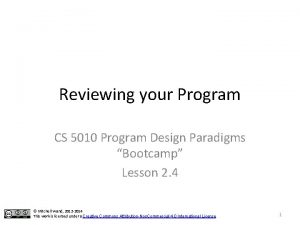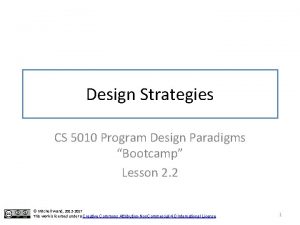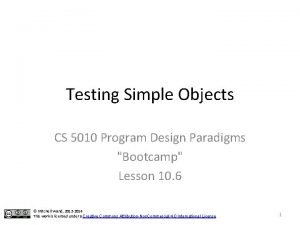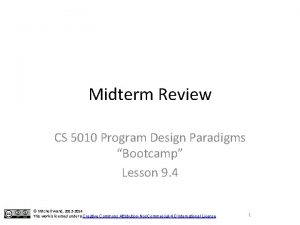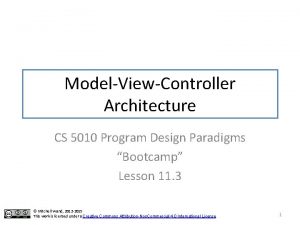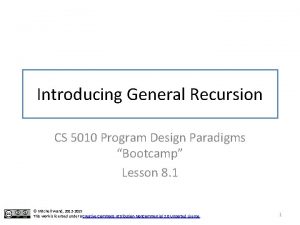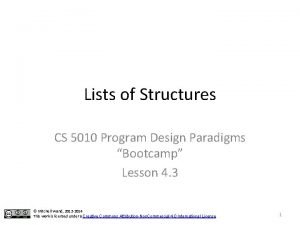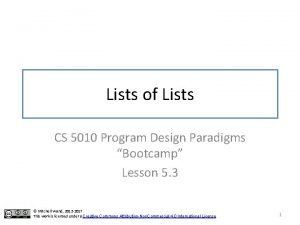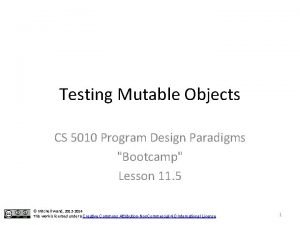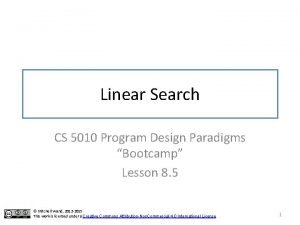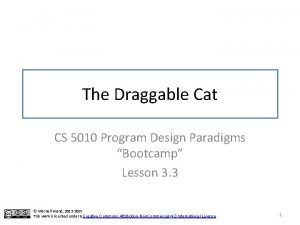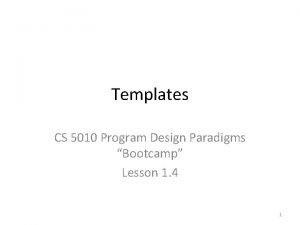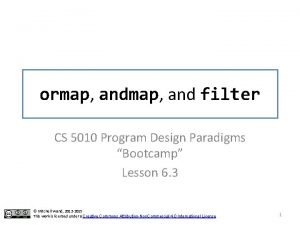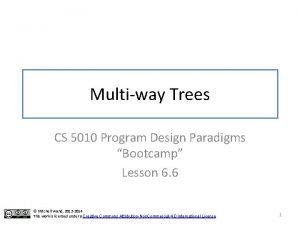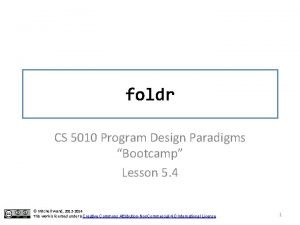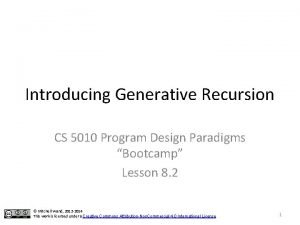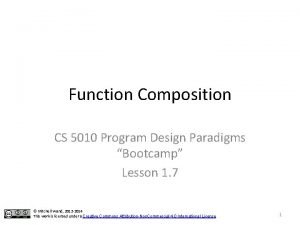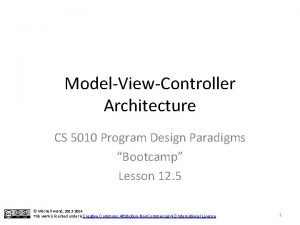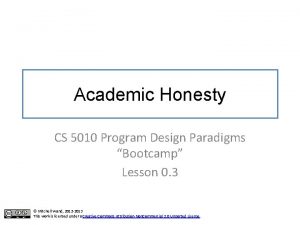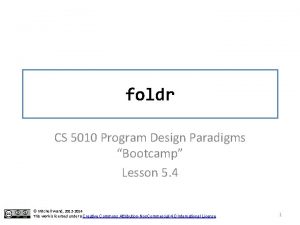Generalizing Similar Functions CS 5010 Program Design Paradigms











![These functions are very similar: (define (find-dog los) (cond [(empty? los) false] [else (or These functions are very similar: (define (find-dog los) (cond [(empty? los) false] [else (or](https://slidetodoc.com/presentation_image_h2/79ba650c7d28b161e5b54c81cd323333/image-12.jpg)













- Slides: 25

Generalizing Similar Functions CS 5010 Program Design Paradigms “Bootcamp” Lesson 5. 1 © Mitchell Wand, 2012 -2014 This work is licensed under a Creative Commons Attribution-Non. Commercial 4. 0 International License. 1

Generalization • The goal of generalization is to avoid having to repeat code, whether the code is identical or slightly different. • In this sequence of lessons, you will learn how to do this, starting with very simple situations, then covering more and more complex situations. 2

Slogans for Generalization • Never write the same code twice – Don’t repeat yourself – Single Point of Control • fix each bug only once • easier maintenance, modification • Copy and Paste is bad practice • Also known as: Refactoring 3

Module Outline • Generalizing a constant to a variable • Generalizing over functions • Using prepackaged generalizations: map, foldr, etc. • A new design strategy: higher-order function composition (HOFC) 4

Data Representations Design Strategies Basics Function Composition Mixed Data Structural Decomposition Recursive Data Module 05 Generalization Over Constants Over Expressions Generalization Functional Data Objects & Classes Stateful Objects Over Contexts General Recursion Communication via State Over Data Representations Over Method Implementations 5

Learning Objectives for this Lesson • By the end of this lesson, you should be able to – recognize when two functions differ only by a constant – rewrite the two functions using a single more general function – test your new function definitions – use the higher-order function composition strategy 6

Imagine the following: • Your boss comes to you and asks you to write a function called find-dog. • You follow the design recipe, write the code, and test it. • Your boss and you are both happy. • Here’s what you wrote: 7

find-dog ; ; find-dog : List. Of. String -> Boolean ; ; GIVEN: a list of strings ; ; RETURNS: true iff "dog" is in the given list. ; ; STRATEGY: structural decomp. on los : List. Of. String (define (find-dog los) (cond [(empty? los) false] [else (or (string=? (first los) "dog") (find-dog (rest los)))])) (check-equal? (find-dog (list "cat" "dog" "weasel")) true) (check-equal? (find-dog (list "cat" "elephant" "weasel")) false) 8

The story continues • The next morning, your boss comes to you and asks you to write find-cat. • You follow the design recipe, write the code, and test it. • Here’s what you wrote: 9

find-cat ; ; find-cat : List. Of. String -> Boolean ; ; GIVEN: a list of strings ; ; RETURNS: true iff "cat" is in the given list. ; ; STRATEGY: structural decomp. on los : List. Of. String (define (find-cat los) (cond [(empty? los) false] [else (or (string=? (first los) "cat") (find-cat (rest los)))])) (check-equal? (find-cat (list "cat" "dog" "weasel")) true) (check-equal? (find-cat (list "elephant" "weasel")) false) 10

A lot of repeated work there! • Your boss is happy, but you are less happy; what if the next day, he asks you to write find-elephant? • You feel like you are wasting a lot of time! • Let’s see just how alike these functions were. 11
![These functions are very similar define finddog los cond empty los false else or These functions are very similar: (define (find-dog los) (cond [(empty? los) false] [else (or](https://slidetodoc.com/presentation_image_h2/79ba650c7d28b161e5b54c81cd323333/image-12.jpg)
These functions are very similar: (define (find-dog los) (cond [(empty? los) false] [else (or (string=? (first los) "dog") (find-dog (rest los)))])) (define (find-cat los) (cond [(empty? los) false] [else (or (string=? (first los) "cat") (find-cat (rest los)))])) The only differences between the functions are their names, and the fact that one refers to “dog” and the other refers to “cat”. 12

So generalize them by adding an argument ; ; find-animal : List. Of. String -> Boolean ; ; returns true iff the given string is in the given los. (define (find-animal los str) (cond [(empty? los) false] [else (or (string=? (first los) str) (find-animal (rest los) str))])) (check-expect (find-animal (list "cat" "elephant" "weasel") "elephant") true) (check-expect (find-animal (list "cat" "elephant" "weasel") "beaver") false) Nothing mysterious here! 13

What did we do here? • If two functions differ only in a few places, add extra arguments for those places. • find-dog and find-cat can be generalized to get find-animal. We replace a constant, like "dog" or "cat" with an argument, here str. • Moving common code to a single function with some extra arguments is what is often called "refactoring". 14

Generalization • Both functions were special cases of a more general function. • The more general function takes extra arguments that express the differences. • The arguments "specialize" the function. • Must make sure that we can to specialize back to our original functions: 15

Confirm that the original functions can still be expressed. (define (find-dog los) (find-animal los "dog")) (define (find-cat los) (find-animal los "cat")) (define (find-elephant los) (find-animal los "elephant")) find-elephant is now a one-liner. Yay! 16

How to test the new definitions • To test the new definitions, comment out the old definitions. This can be accomplished by using the Racket menu item for "comment out with semicolons". • An entire parenthesized expression can also be commented out by prefixing it with #; (see the Help Desk for details). • Do NOT use the Racket menu item "comment out in a box"—the result will be that your Racket file is converted to a form that is no longer plain text, and will not be viewable with ordinary tools (text editors, web browsers, etc. ). 17

Your file should now look like this: #; (define (find-dog los). . . ) ; (define (find-cat los) ; (cond The old definitions are commented out ; . . . ))) (define (find-animal los str). . . ) (define (find-dog los) (find-animal los "dog")) find-dog now refers to the new definition 18

Now your old tests should work WITHOUT CHANGE (check-equal? (find-dog (list true) (check-equal? (find-dog (list false) (check-equal? (find-cat (list true) (check-equal? (find-cat (list false) "cat" "dog" "weasel")) "cat" "elephant" "weasel")) "cat" "dog" "weasel")) The new definitions of find-dog and find-cat are the only ones visible, so these are now testing the new definitions. 19 "elephant" "weasel"))

Another Example: Pizza! ; ; Data Definitions: ; ; A Topping is a String. ; ; A Pizza is a List. Of. Topping ; ; INTERP: a pizza is a list of toppings, listed from top to bottom ; ; pizza-fn : Pizza -> ? ? ; ; (define (pizza-fn p) ; ; (cond ; ; [(empty? p). . . ] ; ; [else (. . . (first p) ; ; (pizza-fn (rest p)))])) The toppings are listed in a certain order, so we must include the order in the interpretation. ; ; Examples: (define plain-pizza empty) (define cheese-pizza (list "cheese")) (define anchovies-cheese-pizza (list "anchovies" "cheese")) 20

replace-all-anchovies-with-onions ; ; : Pizza -> Pizza ; ; GIVEN: a pizza ; ; RETURNS: a pizza like the given pizza, but with ; ; anchovies in place of each layer of onions (define (replace-all-anchovies-with-onions p) (cond [(empty? p) empty] [else (if (string=? (first p) "anchovies") (cons "onions" (replace-all-anchovies-with-onions (rest p))) (cons (first p) (replace-all-anchovies-with-onions (rest p))))])) 21

Opportunities for Generalization We can generalize over onions to get replaceall-anchovies. ; ; ; replace-all-anchovies : Pizza Topping -> Pizza GIVEN: A pizza and a topping RETURNS: a pizza like the given pizza, but with all anchovies replaced by the given topping. 22

Opportunities for Generalization Generalize over anchovies to get replacetopping. ; ; ; replace-topping : Pizza Topping -> Pizza GIVEN: a pizza and two toppings RETURNS: a pizza like the given one, but with all instances of the first topping replaced by the second one. 23

Summary • Functions will sometimes differ only in choice of data items. • Functions can be generalized by adding new argument(s) for the differences. • Confirm the original functions work before generalizing. • Test functions by renaming the originals and running the same tests. 24

Next Steps • Study 05 -1 -find-dog. rkt and 05 -2 -pizza. rkt in the examples folder. • If you have questions about this lesson, ask them on the Discussion Board • Do Guided Practice 5. 1 • Go on to the next lesson. 25
 Generalizing from a sample example
Generalizing from a sample example Nexus 5010 specs
Nexus 5010 specs Cs 5010
Cs 5010 5010 implementation timeline
5010 implementation timeline Airport 5010 data
Airport 5010 data 12,36542 angka penting
12,36542 angka penting Dss 5010
Dss 5010 12,36542 berapa angka penting
12,36542 berapa angka penting Ansi 5010 format
Ansi 5010 format Cs 5010
Cs 5010 Cs 5010
Cs 5010 District 5010
District 5010 Similar disuelve a similar
Similar disuelve a similar Propiedades fisicoquímicas del agua
Propiedades fisicoquímicas del agua Similar disuelve a similar
Similar disuelve a similar Members of an avian species of identical plumage congregate
Members of an avian species of identical plumage congregate Peter hall policy paradigms
Peter hall policy paradigms 4 paradigms of cognitive psychology
4 paradigms of cognitive psychology 7 habits paradigms
7 habits paradigms Syntagmatic and paradigmatic analysis example
Syntagmatic and paradigmatic analysis example Paradigms in hci
Paradigms in hci Distributed systems principles and paradigms
Distributed systems principles and paradigms Message ordering paradigms
Message ordering paradigms Distributed systems principles and paradigms
Distributed systems principles and paradigms Different computing paradigms
Different computing paradigms 3 paradigms
3 paradigms
